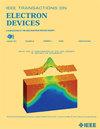硅和SiC功率mosfet中14-MeV中子致损伤的比较
IF 3.2
2区 工程技术
Q2 ENGINEERING, ELECTRICAL & ELECTRONIC
引用次数: 0
摘要
采用14-MeV中子辐照对900 v Si和SiC mosfet的单事件燃尽(SEB)性能进行了比较。在83%额定电压偏置的Si MOSFET中观察到SEB,而在94%额定电压偏置的SiC MOSFET中没有SEB。对于900 v级功率MOSFET,平面SiC器件似乎比Si平面超结器件更具SEB硬化性。得到了Si和SiC器件中14-MeV中子核反应产生的二次离子的线性能量转移(LET)值和范围。在SiC器件中,14-MeV中子诱导二次离子的最大LET值可达9.85 MeV $\cdot $ cm2/mg,根据以往重离子辐照数据,该值足以诱发SEB。相对低能中子不能诱发SEB的机制与次级离子的低范围有关。大多数二次离子的范围小于$3~\mu $ m。有趣的是,在Si器件中,14-MeV中子引起的SEB损伤位于胞区和栅极衬垫之间的过渡区域,这意味着该区域对SEB比超结Si mosfet的胞区更敏感。通过TCAD仿真验证了这一点。本文章由计算机程序翻译,如有差异,请以英文原文为准。
Comparison of 14-MeV Neutron-Induced Damage in Si and SiC Power MOSFETs
The comparison of the single event burnout (SEB) performance between 900-V Si and silicon carbide (SiC) MOSFETs is conducted using 14-MeV neutron irradiation. A SEB is observed for the Si MOSFET biased at 83% of the rated voltage, while no SEB occurs for the SiC MOSFET biased at 94% of the rated voltage. For the 900-V class power MOSFET, the planar SiC device seems more SEB hardened than the Si planar super-junction device. The linear energy transfer (LET) values and ranges of the secondary ions produced by the nuclear reaction of 14-MeV neutrons are obtained for Si and SiC devices. The maximum LET value of the secondary ions induced by 14-MeV neutrons can reach 9.85 MeV $\cdot $ cm2/mg in the SiC device, which is high enough to induce SEB according to the previous heavy ion irradiation data. The mechanisms by which relatively low-energy neutrons are unable to induce SEB are related to the low range of the secondary ions. Most of the secondary ions have a range of less than $3~\mu $ m. It is interesting to note that the SEB damages caused by 14-MeV neutrons in Si devices are located in the transition region between the cell area and the gate pad, which means that this region is more sensitive to SEB than the cell region for super-junction Si MOSFETs. This is verified by the TCAD simulation.
求助全文
通过发布文献求助,成功后即可免费获取论文全文。
去求助
来源期刊

IEEE Transactions on Electron Devices
工程技术-工程:电子与电气
CiteScore
5.80
自引率
16.10%
发文量
937
审稿时长
3.8 months
期刊介绍:
IEEE Transactions on Electron Devices publishes original and significant contributions relating to the theory, modeling, design, performance and reliability of electron and ion integrated circuit devices and interconnects, involving insulators, metals, organic materials, micro-plasmas, semiconductors, quantum-effect structures, vacuum devices, and emerging materials with applications in bioelectronics, biomedical electronics, computation, communications, displays, microelectromechanics, imaging, micro-actuators, nanoelectronics, optoelectronics, photovoltaics, power ICs and micro-sensors. Tutorial and review papers on these subjects are also published and occasional special issues appear to present a collection of papers which treat particular areas in more depth and breadth.
 求助内容:
求助内容: 应助结果提醒方式:
应助结果提醒方式:


